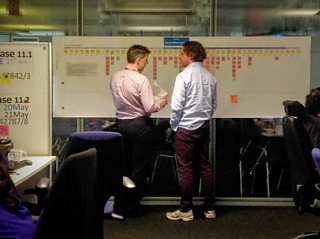Making collaboration count: UXD and Βι¶ΉΤΌΕΔ Editorial Platforms
Leo Marti
User Experience Designer
Tagged with:
In this blog post, User Experience Designer Leo Marti describes some collaborative practices involving Developers, Product Managers and other stakeholders to increase the impact of UX on strategy, accelerate the design process, and establish trust.

At the beginning of my career, I was designing without much involvement from the rest of the team. I thought designing was my responsibility and I didn’t want other people to alter my visions. A couple of years later, I started to realise that when a Product Manager was coming along to research sessions, I didn’t have to fight so hard to sell my ideas anymore. The ideas they were coming up with were much more human-centred. Instead of fighting against them, I could use and build upon them. I now understand that involving the team and opening up the design process is crucially important to craft great experiences for the users.
Involve the team and stakeholders when doing research
To make your product or service more human-centred, the people you work with need to empathise with the users. The first step to make this happening is to invite them when you meet with users so they can witness and experience their feedback and comments. This is particularly efficient because people tend to believe and care more about things they engage with directly, rather than things reported by someone else. Applying this method with the team at the Βι¶ΉΤΌΕΔ has been so successful that the Developers even started to talk to each other about the users over lunch breaks!
In addition, it helps people to understand what you do as a UX Designer, which increases the level of trust they have in you. This can be particularly beneficial when working with a new team or client. You’ll also spend less time defending your design decisions as people will better understand where they come from, and how they will benefit the users. I found that Developers became more flexible once they understood why things need to be changed, and it helps Product Managers to find the right balance between user and business needs for the strategy.
Tips
- Inviting people to short sessions makes it easier to convince them to accept
- Share your findings during standups every time you meet with a user
- Show a short video clip of your usability tests during a team meeting or standup
- If no observation room is available, limit the number of people meeting the user to maximum 2, or it may be overwhelming
Involve the team and stakeholders when analysing the findings
Once your team and stakeholders empathise with your users, the next step is to make sure the research findings are understood. This is important to make sure they will get used to shape the roadmap and strategy. In the past, I often created personas and that I presented and stuck on the wall, but most of the time the team wouldn’t engage with them. Involving the team – especially the Product Managers – when analysing and visualising the findings turned out to be much more efficient. People assimilate information better when they engage with it than when they passively consume it.
To make the team engage with the research findings, I like to organise workshops in which we collectively analyse the research findings and create artefact such as . In addition to helping everyone assimilate the findings, it will speed up the analysis process – less documentation to create and more people to go through the data.
Here is how you can proceed:
- Clean up your research findings’ notes
- Create a user journey before the workshop and stick it on the wall. You can add touch points and persona on it, or do it during the workshop.
- At the start of the workshop, distribute your research findings notes to the workshop participants and assign participant(s) to a user.
- Ask the participants to write the pain points and happy points on red and green post-its and to stick them on the wall.
- Ask them to group similar post-its together and to give a title to each group.
- This is your Mental Model Map - take a picture!
- Ask them to map the group’s titles on the user journey. If it makes more sense for you, you can map all the pain and happy points under the user journey.
- This is the start of your Experience Map! You might want to clean it up and complete it.
You can follow a similar approach with your favourite analysis method, map, or persona!

Tips
- Keeping the workshop short will make it easier to convince people to accept
- Make the workshop useful for you as well (e.g. it helps you to analyse the research findings)
I recently organised a similar workshop with the team and it really had a positive effect on helping the team understand and use the research findings. The map helped facilitate discussions and discover new opportunities for the product. Many of the research findings have also been used by the Product Owner to shape the roadmap and strategy.

Conclusion
In order to maximise the impact your UX work has on the strategy and make the design process run faster and smoother, don’t be scared to open up; especially if you work with a difficult team or stakeholders. Involve others when you do user research and analyse findings as it will help you gain trust, make the entire team and stakeholders more human-centred and help you better understand the goals and interests of your colleagues from other disciplines, which is the key to better collaboration.
Which techniques do you use to collaborate with your colleagues? How do you influence the strategy? Let’s collaborate!
